I’m sitting in the Skyteam Lounge at Vancouver International Airport waiting to board my flight (free access to the lounge thanks to the Scotiabank Passport Visa Infinite) while writing this little introduction section.
As the blog post title suggests, I’m on yet another business trip to Asia. This time around, I’ll spend 11 days in Taiwan, China, and Hong Kong, visiting our regional offices and customers.
My calendar over the next 11 days will be jam-packed. I also have many work lunches and dinners throughout the entire trip. Fortunately, I’ll have time to tour around Taiwan on the weekend before hopping on a flight to Hong Kong on Sunday afternoon.
I plan to write this blog post as random thoughts arise during my trip. Unlike my other random thought trip posts, I won’t publish this post while I’m in Asia. Instead, it will go live once I’m back in Vancouver.
A very long first day…again
Rather than leaving Saturday at 1 AM and losing my entire weekend for the trip, I opted to leave on Sunday morning (so I could spend Saturday with my family).
Leaving Sunday morning meant I landed at Taiwan Taoyuan Airport before the crack of dawn at 4:15 AM on Monday. It also meant I had a very long day ahead of me.
I managed to sleep for about six hours on the flight, which was very decent for me. After getting out of the airport, I headed to the hotel to freshen up and have a quick nap before meeting up with a co-worker at the hotel lobby at 8:30 AM to head into our office in New Taipei together.
After several internal meetings and a team lunch, I headed out with our Sales team to meet a customer to go over the product portfolio that I manage. The day was fueled by several cups of coffee.
There was no dinner planned that very first day (unlike my previous trips to Taiwan), so I was able to have a slow-paced dinner and relax a bit.
I was hoping to have a relaxing first night in Taiwan. But that didn’t happen. The week before the trip, a North American colleague scheduled an internal meeting at 7 AM Pacific between North American and European co-workers. When you calculate the time change, it meant the call was on Monday at 10 PM Taipei time.
Despite trying very hard to avoid a very long day, I was not successful…
Random Thought #1
A handful of my coworkers in Taiwan know about this blog and read it occasionally. So when we chat over meals or during breaks, sometimes we end up talking about investing.
Some coworkers pointed out that many technology stocks like TSMC, Getac, MediaTek, Inventec, etc have been on a tear lately. A few of them have been actively investing in these big Taiwanese technology companies but most of my coworkers stated that they “got out” too early and didn’t materialize the big gain.
I couldn’t help but mention to them that they shouldn’t put all their money in one basket – by investing in high tech companies. I reminded them that high tech company stocks are usually very volatile. Heck, even our company and the previous company (before the acquisition) are often volatile. Sometimes the stocks would drop even after a very solid earnings report.
Given how easy it is to invest now, thanks to index ETFs and all-in-one ETFs, I suggested these coworkers stay diversified with their investments.
Slow and steady wins the game!
Random Thought #2
Per the chart below, the monthly consumer inflation rate hovers between 1.5% to 3.5% so it is not completely unreasonable.
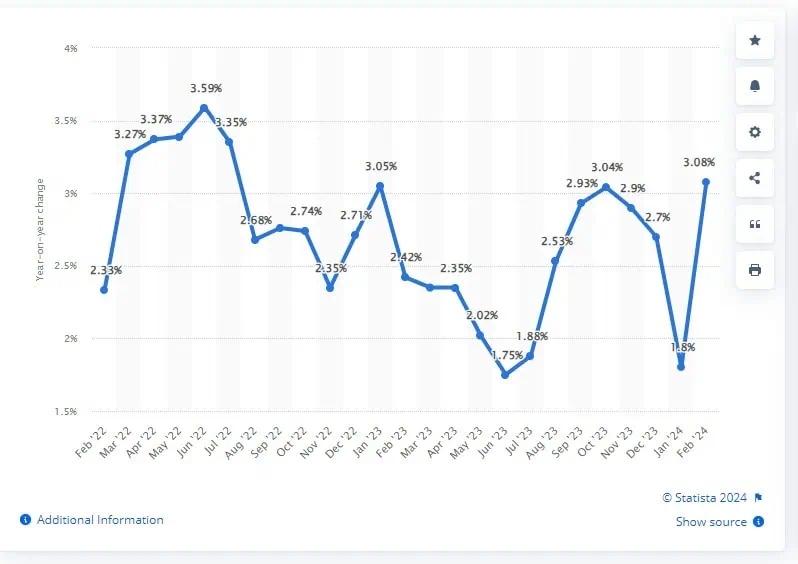
While the cost of living in Taipei is still relatively cheaper than in Vancouver, I have noticed that some prices have crept up compared to last year when I was in Taiwan.
Some food items have increased in price by 10-20% over the last year. Some even higher. Given the lower average salaries in Taiwan, some people are having a tough time keeping up with the increase in the cost of living.
A cup of oat milk latte from Starbucks is about $6 Canadian, roughly the same price as Vancouver but it’s considered quite expensive by Taiwanese standards. However, I am surprised that Starbucks is usually packed with people and often with people in their 20s and 30s.
Some items are cheaper in Taipei. For example, a bowl of ramen from Hokkaido Ramen Santouka is about $20 in Vancouver. Meanwhile, the same bowl of ramen is $270 NTD or about $12 Canadian.
When asked around, I learned that many Taiwanese in their 20s and 30s have given up on saving money, because things are so expensive especially when compared to their monthly salaries. They have no way to save up to purchase an apartment. Instead of feeling depressed, they spend most or all of their money each month, living it up, and essentially living paycheque to paycheque.
It’s typical for Taiwanese families to emphasize living below their means and saving money for the future. These simple and important concepts were ingrained in me by my parents. Needless to say, I was very surprised to hear about this 180 degree shift in the saving mentality. If the younger generations are to keep up with this spending habit (I’m sounding like an old fart here by saying younger generations), I do worry about the prosperity and future of Taiwan…
Another thing that surprises me greatly is the number of department stores in Taiwan. Walking around in Taipei, I’d come across many different department stores. For example, around the Taipei City Hall MRT station, there are several department stores – Uni-President Department Store, Shin Kong Mitsukoshi, and Breeze. There’s also Elite Spectrum which is a department store dedicated to books and stationeries (think Indigo/Chapters but department store size with multiple floors). Then not too far away there were multiple Sogo department store buildings. Some of these department stores, like Shin Kong Mitsukoshi, have multiple buildings in the same area.
Do people in Taiwan purchase things from department stores that often to keep these fancy stores afloat? I guess so. Meanwhile, in Canada department stores like The Bay can barely stay profitable and some like Sears have gone out of business.
Random Thought #3
The last time I visited Shenzhen was in November 2019, before COVID. So it has been almost four and half years.
I took the ferry directly from Hong Kong Airport to Shenzhen Shekou Port. When I got outside of the customs building, I was amazed at all the new developments around the port. Back in 2019, the surrounding areas by Shekou Port were simply fields with a few old buildings. There were a lot of fancy new high-rises and massive highways in the surrounding areas.
My hotel was in the new Shenzhen Technology Park and I noticed a lot more high rises than back in 2019 (I stayed in the same area last time too). Many of the buildings were probably built within the last three or so years.
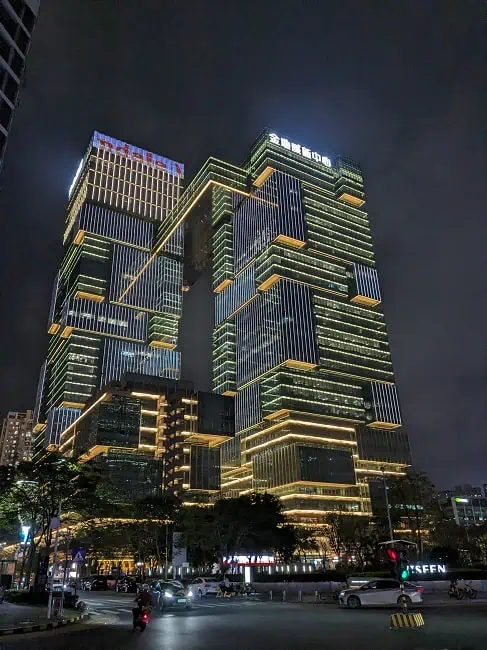
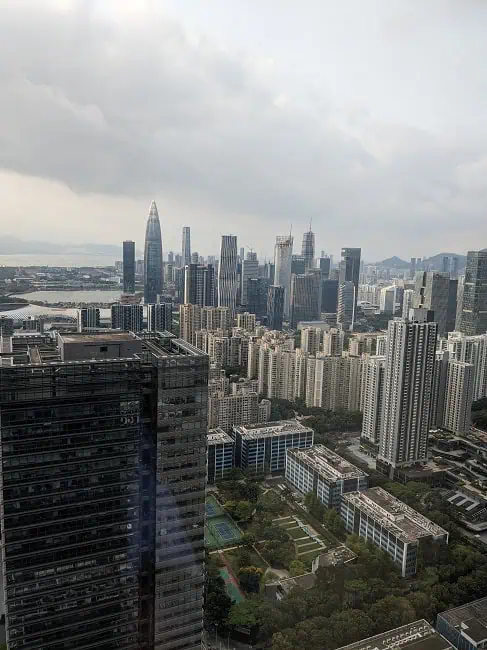
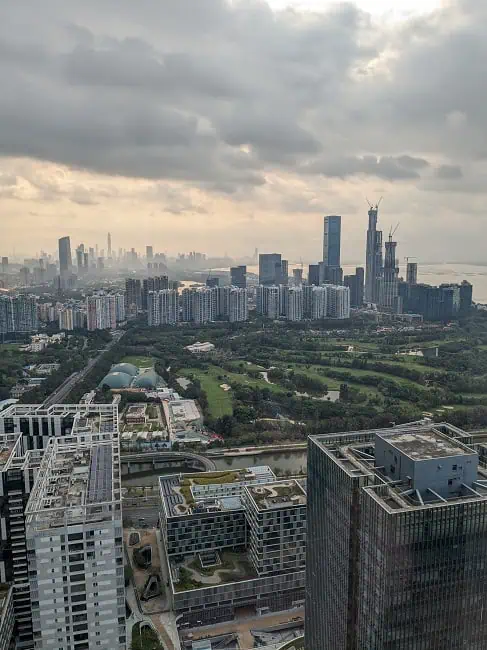
According to my coworkers, most of the new buildings are for offices but there are many apartments as well. They said that these apartments are currently the most expensive in Shenzhen, going for 300,000 to 350,000 Chinese Yuan per pyeong, or about $1,600 to $1,850 Canadian per square foot. In other words, for a 1,000 square foot apartment, it would cost anywhere from $1.6 million to 1.85 million Canadian dollars.
Even in an area that’s further out, my coworkers said apartments are going for anywhere from 150,000 to 200,000 Chinese Yuan per pyeong, or about $800 to $1,000 Canadian per square foot. Either way, real estate in Shenzhen is very expensive.
We visited a few customers about 40 km north of Shenzhen city centre. It was like going back in time by ten or 15 years. Outside of the Shenzhen city centre, buildings were much older and there were many open fields around. However, I noticed that the roads were newly developed, typically three to four lanes in each direction and there were a few new construction projects here and there. I would not be surprised if this area is filled with new high rises in a year or two from now…
Random Thought #4
Back in 2019, all the taxis in Shenzhen were electric. This time around, not only all the taxis were electric, all the DiDi cars (aka Chinese Uber) were electric too. There were a lot of BYD EVs and there were also many EVs made by Chinese brands like Aion, Hozon, and Xpeng. All these EVs were very fancy looking and typically shared similar looks as Tesla, Lucid, and Porsche.
I rode in a few of these Chinese EVs while in Shenzhen and they were super nice inside.
I saw a few Tesla Model 3, Model Y, and Model S in Shenzhen but they were not nearly as common as Chinese EVs. Oddly enough, when I was in Hong Kong I saw a lot more Teslas but not really any Chinese EVs around.
As a Tesla investor, I do wonder how well Tesla can capture the Chinese EV market. Perhaps that’s why Tesla has kept lowering prices in China over the last few years…
Random Thought #5
I crossed the China-Hong Kong border on April 1st, Easter Monday. As Hong Kong had a four-day holiday, the border area had major traffic jams. I had never seen so many people walking across Futian Port Crossing. According to the DiDi driver in Shenzhen, almost 1 million Hong Kong people crossed the border to visit Shenzhen during the four-day long weekend.
Considering Metro Vancouver’s population is about 2.6 million in 2024, that would be similar to 40% of Metro Vancouver’s population walking and driving across the US border over a long weekend to go to Bellingham, Washington. For me, that vast number was hard to comprehend. It shouldn’t come as a surprise that it was packed in the metro when I arrived in Hong Kong…
The reason for so many Hong Kong people (aka Hongkongers) visiting Shenzhen?
Cheaper prices. Shenzhen prices are about 30% cheaper than Hong Kong. So many Hongkongers go to Shenzhen for vacation and to shop for groceries. Over lunch, a Hong Kong coworker said they recently went to Shenzhen Zoo for a short vacation. A yakitori dinner for a family of five was about 450 CNY. The coworker commented it would have cost at least double or triple for the same type of food in Hong Kong.
Since the series of Hong Kong protests between 2019 and 2020, some companies have moved their offices from Hong Kong to Singapore, Taiwan, and other Asian countries. Because many Hongkongers hold Canadian and UK passports, many of them have moved out of the small island.
If such an epic exodus were to continue, I do wonder what’s going to happen to Hong Kong. Perhaps five years from now, Hong Kong will no longer be one of the major economic hubs in Asia.
Random Thought #6
I toured around Beijing, Shanghai, and Shenzhen in 2019. Back then, cash was not widely accepted/ Even credit cards were a hit-and-miss proposition depending on the place. This time around, I was told that cash wasn’t accepted in Shenzhen. This meant I had to ask a local co-worker to pick me up to take me to the hotel. While riding the taxi, I confirmed with the driver that they wouldn’t accept cash at all. Credit cards were not accepted either.
Walking around by my hotel, I noticed convenience stores would only accept payment via WeChat, Alibaba, or UnionPay. Local food places also wouldn’t accept cash or credit cards. This meant as a tourist, it was very difficult to get around Shenzhen (and I’m sure China in general too).
The only place I had luck with using my credit card was at a Starbucks. Even then, I had to explain to the worker that I was not local and had to use a foreign credit card. The worker had to bring out another machine for my credit card…
Random Thought #7
It was interesting to see the price differences among Taiwan, Shenzhen, and Hong Kong.
As mentioned, a cup of oat milk latte in Taiwan was about $6 Canadian. The same drink from Starbucks was about $7 Canadian in Shenzhen and $8.50 in Hong Kong.
One night I had Cantonese food at the Sha Tin shopping mall. Two dim sum dishes, a beef fried noodle, and a cup of milk tea were $306.90 HKD or almost $54 Canadian. It was anything but cheap!
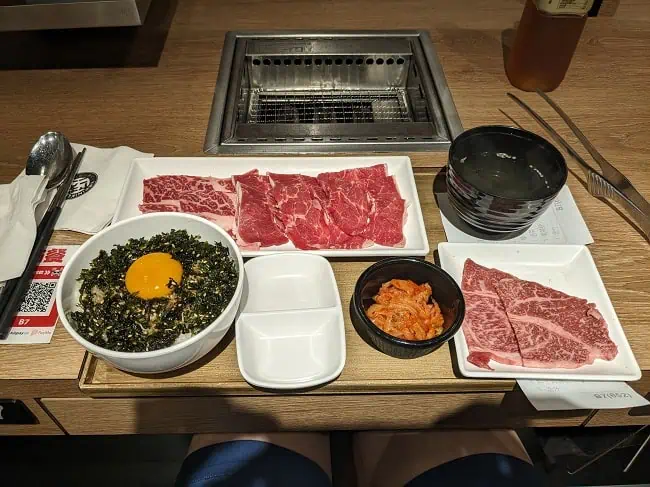
During my short visit, my coworkers and I went to a “fancier” local coffee shop in One Pacific Centre and a cup of oat milk latte was $53 HKD or $9.20 Canadian.
Ouch!
No wonder so many Hong Kong people went over to Shenzhen during the Easter long weekend!
One of the reasons why things are so expensive in Hong Kong is because the rent is so high, so vendors pass the high prices down to the customers. The cost of living certainly is very high in Hong Kong, no wonder not many people can afford to own an apartment in Hong Kong.
Side Note
Taiwan experienced 7.4 magnitude earthquake, the biggest in 25 years on April 3rd. Fortunately I was in Hong Kong that day and didn’t experience it (I did experience the 6.4 magnitude earthquake while quarantining back in September 2022). Fortunately all my extended family, friends, and co-workers are OK in Taiwan.
I received some pictures and videos from coworkers and I was amazed by how powerful the earthquake was and all the damages it caused. I connected via Taiwan on my way back to Vancouver the next day and saw some damages first hand.
Anyway, I felt fortunate not to be in Taiwan to experience this powerful earthquake… I have some thoughts on it but I’ll leave them for another post…

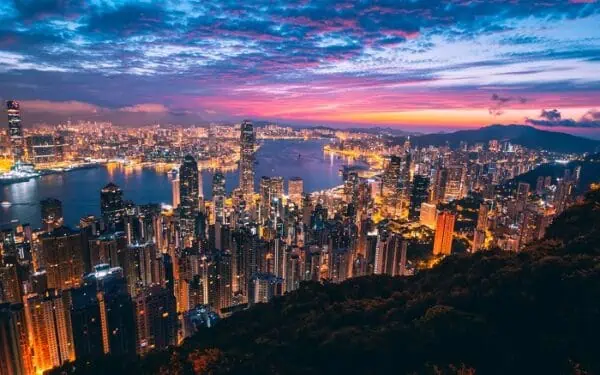
What is the real reason do think in Shenhzen for not accepting credit card payment, as per your remarks?
Is it the extra fee that credit card companies might charge to the vendor for smaller payments?
It’s simply not accepted at the restaurants/stores I went. The hotel I stayed did accept credit cards.
I think the key reason is that people are so used to payment via WeChat so that’s what they use in China. It could be the extra fee too. Not 100% sure to be honest.
Thanks Bob for putting these thoughts together on your visit to Taiwan, HK, and China. Lots of thinking on your part.
With respect to merchants not accepting cash and credit, how does one pay? How are these payment cards filled? Something for me to consider…
Hi Daniel,
It’s all payment via WeChat in China. Vendors also accept UnionPay from here there.
For foreigners visiting, can they connect foreign bank accounts to their WeChat accounts easily?
What do you recommend?
I living in Shenzhen from 2003-2013 it is crazy how much it has grown.
That must have been pretty crazy so experience all the developments and changes during that time period.
You must use randon in place of random a lot.
Oops, fixed.
Thank you for a well thought-out piece, Bob. Not so random at all! In 1975 I was in Hong Kong after a month in PRC, travelling out from Bejing into many parts of the country. The Chinese were very hospitable to us at all times, but it was nice to get back to comfort in Hong Kong.
Wow 1975… China must have been very different back then.
Love cash!
Thank you for the great interview in your last blog post with Henry Wah.
I went to his website to read what he has to say; turns out his philosophy is quite a bit similar to mine when it comes to investing.
You’re very welcome Pierre.
Thank you for your random thoughts. I wonder if we are headed in the same direction in regards with payments and high prices. I still pay my groceries with cash so I know how much I spend and I really hope cash will stay.
Hopefully inflation will settle down so prices don’t continue to climb.
I’m all for going more digital payments but you need to find the right balance. Also need to be mindful for tourists visiting the country.